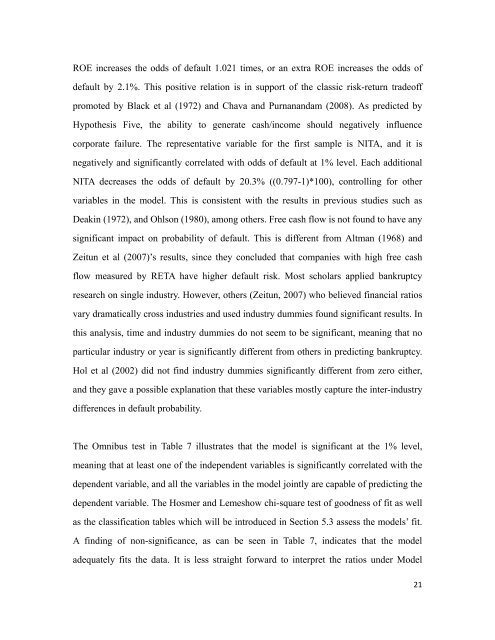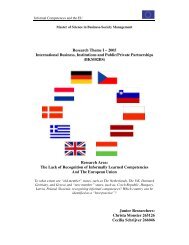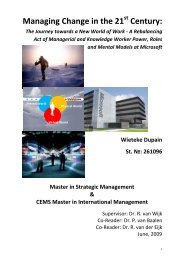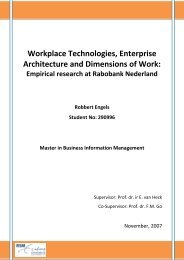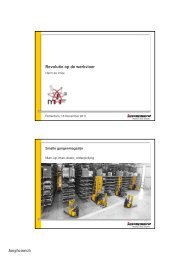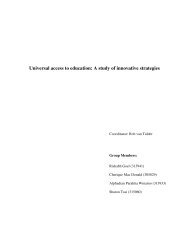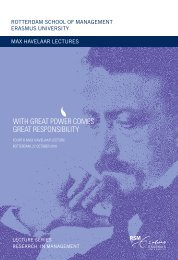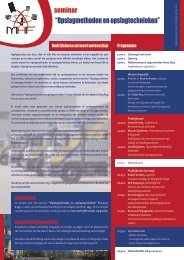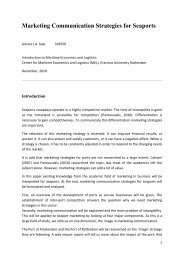Financial Ratios as Predictors of Failure: Evidence from ... - ERIM
Financial Ratios as Predictors of Failure: Evidence from ... - ERIM
Financial Ratios as Predictors of Failure: Evidence from ... - ERIM
Create successful ePaper yourself
Turn your PDF publications into a flip-book with our unique Google optimized e-Paper software.
ROE incre<strong>as</strong>es the odds <strong>of</strong> default 1.021 times, or an extra ROE incre<strong>as</strong>es the odds <strong>of</strong><br />
default by 2.1%. This positive relation is in support <strong>of</strong> the cl<strong>as</strong>sic risk-return trade<strong>of</strong>f<br />
promoted by Black et al (1972) and Chava and Purnanandam (2008). As predicted by<br />
Hypothesis Five, the ability to generate c<strong>as</strong>h/income should negatively influence<br />
corporate failure. The representative variable for the first sample is NITA, and it is<br />
negatively and significantly correlated with odds <strong>of</strong> default at 1% level. Each additional<br />
NITA decre<strong>as</strong>es the odds <strong>of</strong> default by 20.3% ((0.797-1)*100), controlling for other<br />
variables in the model. This is consistent with the results in previous studies such <strong>as</strong><br />
Deakin (1972), and Ohlson (1980), among others. Free c<strong>as</strong>h flow is not found to have any<br />
significant impact on probability <strong>of</strong> default. This is different <strong>from</strong> Altman (1968) and<br />
Zeitun et al (2007)’s results, since they concluded that companies with high free c<strong>as</strong>h<br />
flow me<strong>as</strong>ured by RETA have higher default risk. Most scholars applied bankruptcy<br />
research on single industry. However, others (Zeitun, 2007) who believed financial ratios<br />
vary dramatically cross industries and used industry dummies found significant results. In<br />
this analysis, time and industry dummies do not seem to be significant, meaning that no<br />
particular industry or year is significantly different <strong>from</strong> others in predicting bankruptcy.<br />
Hol et al (2002) did not find industry dummies significantly different <strong>from</strong> zero either,<br />
and they gave a possible explanation that these variables mostly capture the inter-industry<br />
differences in default probability.<br />
The Omnibus test in Table 7 illustrates that the model is significant at the 1% level,<br />
meaning that at le<strong>as</strong>t one <strong>of</strong> the independent variables is significantly correlated with the<br />
dependent variable, and all the variables in the model jointly are capable <strong>of</strong> predicting the<br />
dependent variable. The Hosmer and Lemeshow chi-square test <strong>of</strong> goodness <strong>of</strong> fit <strong>as</strong> well<br />
<strong>as</strong> the cl<strong>as</strong>sification tables which will be introduced in Section 5.3 <strong>as</strong>sess the models’ fit.<br />
A finding <strong>of</strong> non-significance, <strong>as</strong> can be seen in Table 7, indicates that the model<br />
adequately fits the data. It is less straight forward to interpret the ratios under Model<br />
21


